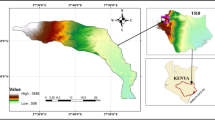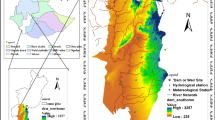Abstract
Vegetation information is seldom considered in lumped conceptual rainfall-runoff models. This paper uses two modified rainfall-runoff models, the Xinanjiang-ET and SIMHYD-ET models in which vegetation leaf area index is incorporated, to investigate impacts of vegetation change and climate variability on streamflow in a Southern Australian catchment, the Crawford River experimental catchment, where Tasmanian blue gum plantations were introduced gradually from 1998 till 2005. The Xinanjiang-ET and SIMHYD-ET models incorporate remotely-sensed leaf area index (LAI) data obtained from the Advanced Very High Resolution Radiometer (AVHRR) on board NOAA polar orbiting satellites. Compared to the original versions, the Xinanjiang-ET and SIMHYD-ET models show marginal improvements in runoff simulations in the pre-plantation period (1882–1997). The calibrated Xinanjaing-ET and SIMHYD-ET models are then used to simulate plantation impact on streamflow in the post-plantation period. The total change in streamflow between the pre-plantation and post-plantation periods is −32.4 mm/a. The modelling results from the two models show that plantation reduces streamflow by 20.5 mm/a, and climate variability reduces streamflow by 11.9 mm/a. These results suggest that increase in plantations can reduce streamflow substantially, even more than climate variability.
Similar content being viewed by others
Explore related subjects
Discover the latest articles and news from researchers in related subjects, suggested using machine learning.References
Kittredge J. Forest Influences: The Effects of Woody Vegetation on Climate, Water, and Soil, with Appliactions to the Conservation of Water and the Control of Floods and Erosion. New York: Dover Publications, 1948
Bronstert A, Niehoff D, Burger G. Effects of climate and land-use change on storm runoff generation: present knowledge and modelling capabilities. Hydrol Process, 2002, 16(2): 509–529
Cheng G W, Yu X X, Zhao Y T. Hydrological Cycle in Mountain Forest Ecosystem and its Mathematical Modeling (in Chinese). Beijing: Science Press, 2004
Eagleson P S. Ecohydrology: Darwinian Expression of Vegetation Form and Function. Cambridge: Cambridge University Press, 2002
Zhao F F, Xu Z X, Zhang L, et al. Streamflow response to climate variability and human activities in the upper catchment of the Yellow River Basin. Sci China Ser E-Tech Sci, 2009, 52(11): 3249–3256
Bosch J M, Hewlett J D. A review of catchment experiments to determine the effect of vegetation changes on water yield and evapo-transpiration. J Hydrol, 1982, 55(1–4): 3–23
Ruprecht J K, Schofield N J. Effects of partial deforestation on hydrology and salinity in high salt storage landscapes. II. Strip, soils and parkland clearing. J Hydrol, 1991, 129(1–4): 39–55
Whitehead P G, Robinson M. Experimental basin studies-an international and historical-perspective of forest impacts. J Hydrol, 1993, 145(3–4): 217–230
Li C R, Tu L B. The influence of forests on the annual flow in rivers and its significance (in Chinese). J Nanjing Forest Uni, 1983, 3: 31–43
Zhou X F, Zhao H X, Sun H Z. Proper assessment for forest hydrological effect (in Chinese). J Nat Resour, 2001, 16: 420–426
Liu C M, Zhong J X. The influence of forest cover upon annual runoff in the loess plateau of China (in Chinese). Acta Geographica Sinica, 1978, 33(2): 112–127
Chen J F, Li X B. The impact of forest change on watershed hydrology — Discussing some controversies on forest hydrology (in Chinese). J Nat Resour, 2001, 16(5): 474–480
Fu C S, Chen J Y, Zeng S Q, et al. An overview on the water science researches at the experimental catchments in China and Abroad (in Chinese). Prog Geograp, 2011, 30(3): 259–267
Zhao F F, Zhang L, Xu Z X, et al. Evaluation of methods for estimating the effects of vegetation change and climate variability on streamflow. Water Resour Res, 2010, 46, doi: 10.1029/2009wr007702
Morton F I. Operational Estimates of Areal Evapo-Transpiration and Their Significance to the Science and Practice of Hydrology. J Hydrol, 1983, 66(1–4): 1–76
Monteith J L. Evaporation and environment. Symp Soc Exp Biol, 1965, 19: 205–234
Leuning R, Zhang Y Q, Rajaud A, et al. A simple surface conductance model to estimate regional evaporation using MODIS leaf area index and the Penman-Monteith equation. Water Resour Res, 2008, 44, doi: 10.1029/2007WR006562
Li H X, Zhang Y Q, Chiew F H S, et al. Predicting runoff in ungauged catchments by using Xinanjiang model with MODIS leaf area index. J Hydrol, 2009, 370(1–4): 155–162
Zhao R J. The Xinanjiang Model Applied in China. J Hydrol, 1992, 135(1–4): 371–381
Zhao R J, Zhang Y L, Fang L R, et al. The Xinanjiang Model. In: Hydrological Forecasting Proceedings Oxford Symposium. Oxford: IASH, 1980. 351–356
Wu X Y, Cheng C T, Zhao M Y. Parameter calibration of Xinanjiang rainfall-runoff model by using parallel genetic algorithm. J Hydraul Eng, 2004, 11: 85–90
Jayawardena A W, Zhou M C. A modified spatial soil moisture storage capacity distribution curve for the Xinanjiang model. J Hydrol, 2000, 227(1–4): 93–113
Cheng C T, Ou C P, Chau K W. Combining a fuzzy optimal model with a genetic algorithm to solve multi-objective rainfall-runoff model calibration. J Hydrol, 2002, 268(1–4): 72–86
Chiew F H S, Peel M C, Western A W. Application and testing of the simple rainfall-runoff model SIMHYD. In: Singh V P, Frevert D K, eds. Mathematical Models of Small Watershed Hydrology and Application. Littleton: Water resources Publication, 2002. 335–367
Chiew F H S. Estimation of rainfall elasticity of streamflow in Australia. Hydrolog Sci J, 2006, 51(4): 613–625
Zhang Y Q, Chiew F H S. Relative merits of different methods for runoff predictions in ungauged catchments. Water Resour Res, 2009, 45, doi: 10.1029/2008WR007504
Chiew F H S, Peel M C, Western A W. Application and testing of the simple rainfall-runoff model SIMHYD. In: Singh V P, Frevert D K, eds. Colorado: Water Resources Publication, 2002. 335–367
Yildiz O, Barros A P. Elucidating vegetation controls on the hydroclimatology of a mid-latitude basin. J Hydrol, 2007, 333(2–4): 431–448
Zhang Y Q, Chiew F H S, Zhang L. Use of remotely sensed actual evapotranspiration to improve rainfall-runoff modeling in Southeast Australia. American Meteor Society, 2009, 10(4): 969–980
Lewis R M. Torczon V. Pattern search algorithms for bound constrained minimization. Siam J Optimiz, 1999, 9(4): 1802–1099
Lewis R M. Torczon V. Pattern search methods for linearly constrained minimization. Siam J Optimiz, 2000, 10(3): 917–941
Nash J E, Sutcliffe J V. River flow forecasting through conceptual models part I-A discussion of principles. J Hydrol, 1970, 10(3): 282–290
Zhang X P, Zhang L, Zhao J, et al. Responses of streamflow to changes in climate and land use/cover in the Loess Plateau, China. Water Resour Res, 2008, 44, doi: 10.1029/2007WR006711
Wang G Q. Impacts of climate change on hydrology and water resources in the middle reaches of the Yellow River Basin (in Chinese). Dissertation of Doctoral Degree. Nanjing: Hohai University, 2006
Li D F. Impact of climate and land-cover change on runoff of the source regions of the Yellow River (in Chinese). Dissertation of Doctoral Degree. Beijing: Beijing Normal University, 2003
Author information
Authors and Affiliations
Corresponding author
Rights and permissions
About this article
Cite this article
Li, H., Zhang, Y. & Wang, B. Separating impacts of vegetation change and climate variability on streamflow using hydrological models together with vegetation data. Sci. China Technol. Sci. 55, 1964–1972 (2012). https://doi.org/10.1007/s11431-012-4859-9
Received:
Accepted:
Published:
Issue Date:
DOI: https://doi.org/10.1007/s11431-012-4859-9
Keywords
Profiles
- YongQiang Zhang View author profile




